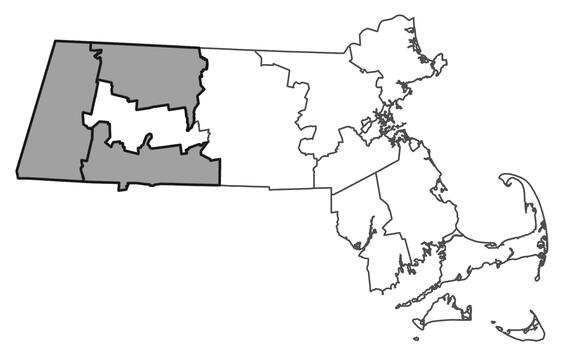- Scientific name: Asplenium ruta-muraria L.
- Species of Greatest Conservation Need (MA State Wildlife Action Plan)
- Threatened (MA Endangered Species Act)
Description
Wall-rue spleenwort. Photo credit: Bryan Connolly
The wall-rue spleenwort (Asplenium ruta-muraria) is a small, delicate, evergreen fern with branched fronds 4-17 cm (1.5-7 in) long. It is a member of the spleenwort family (Aspleniaceae). It typically grows in clusters or tufts on dry limestone, conglomerate, or traprock cliffs and ledges. The small, fan-shaped leaflets are bluish-green or olive-green, have toothed or indented margins, and are borne on somewhat rigid stalks. The species’ common and scientific names have European origins. It is named for its resemblance to the European rue (genus Ruta) and for its tendency to grow on rock walls (in Latin, murus) and buildings in Europe.
The fronds of the wall-rue spleenwort are bipinnate (or twice-divided), unlike the other spleenworts in our region, which are simply pinnate (once-divided). The clusters of sori (spore-producing structures) on the underside of the leaflets are short and oblong, are oriented along the veins, and are detectable from June through September. The plants often have many dead stalks attached to the roots. In times of drought, the plant dries up and may appear dead but will revive quickly with rain.
Mountain spleenwort (Asplenium montanum) superficially resembles wall-rue spleenwort, but its leaflets are not fan-shaped or as delicately cut. In addition, mountain spleenwort is more commonly found on non-calcareous cliffs. Young fragile fern (Cystopteris fragilis) is sometimes difficult to distinguish from wall-rue spleenwort, but its leaves are much thinner-textured (nearly translucent). Mature fragile fern is several times larger than wall-rue spleenwort, and its leaves are subopposite with triangular leaflets. In addition, the sori of fragile fern are nearly round, compared to the more elongate sori of wall-rue spleenwort. Finally, one might confuse maidenhair spleenwort (Asplenium trichomanes), a common associate, with wall-rue spleenwort. However, the maidenhair spleenwort frond is merely pinnate (versus bipinnate), the frond shape is linear (vs. more triangular), and the rachis is brown (instead of green).
Life cycle and behavior

These plants grow new leaves in May. The fertile and sterile fronds are similar in appearance. As noted, during a period of drought, plants will dry up and appear dead but will revive once rain returns. Wall-rue spleenwort is evergreen so is identifiable throughout the year. Spores will be released from the sori and wind dispersed mid to late summer.
Population status
Wall-rue spleenwort is listed under the Massachusetts Endangered Species Act as Threatened. All listed species are protected from killing, collecting, possessing, or sale and from activities that would destroy habitat and thus directly or indirectly cause mortality or disrupt critical behaviors. There are ten populations in the state that have been verified extant within the past 25 years and two historical occurrences, all of which are in western Massachusetts in Franklin, Hampden, and Berkshire counties.
Distribution and abundance
Wall-rue spleenwort is a circumboreal species of North America, Europe and eastern Asia. In North America, it occurs as var. cryptolepis, a tetraploid. In Europe and east Asia, both diploids and tetraploids occur and the exact relationships between the species on different continents are not known. In North America, wall-rue spleenwort is known from Massachusetts, Connecticut, and Vermont with a disjunct historical population that occurred in Rhode Island. It currently does not occur in Maine, New Hampshire, and Rhode Island. Wall-rue spleenwort is known in New Brunswick, westward to southwestern Ontario, Michigan, and Iowa. It is found south through the Appalachians to Georgia and Alabama and westwards to the Ozarks in Arkansas. It is considered rare in several states, particularly at the edges of its range. In New England, Connecticut and Massachusetts list this species as imperiled, and Vermont lists it as vulnerable.

Distribution in Massachusetts
1999-2024
Based on records in the Natural Heritage Database
Habitat
Wall-rue spleenwort is found in shaded to open sites, primarily in cracks and fissures on dry ledges of dolomitic limestone and conglomerate rock. It commonly occurs with maidenhair spleenwort, fragile fern, purple cliff-brake (Pellaea atropurpurea), columbine (Aquilegia canadensis), harebell (Campanula rotundifolia), and thread-leaf sedge (Carex eburnea).
Healthy habitats are vital for supporting native wildlife and plants. Explore habitats and learn about conservation and restoration in Massachusetts.
Threats
Reasons for wall-rue spleenwort’s rarity in Massachusetts include the scarcity of appropriate habitat in the state, over-collecting in the past (it is illegal to collect currently as it is a MESA-listed species), and recreational activities, including rock-climbing, that trample individuals. Invasive plants may also threaten the population.
Conservation
Survey and monitoring
Surveys for wall-rue spleenwort are needed on a regular basis as they are for all listed species, at least every 5 to 10 years. Surveys can be completed throughout the year as it is an evergreen species. If monitoring during a drought, surveys should be completed after the drought has ended to ensure the population extents can be determined.
Management
As for many rare species, the exact needs for management of the wall-rue spleenwort are not fully known. The following comments are based primarily on observation of populations in Massachusetts. Threats to this species include development, rock climbing, invasive plant species, and over-collection in the past. Protection of calcareous cliff communities should be a conservation priority in the state due to their relative rarity, as well as the interesting and unusual plants they support. Rock climbing should be prevented or discouraged on calcareous cliffs for both safety and conservation reasons. All active management of rare plant populations, including invasive species removal, is subject to review under the Massachusetts Endangered Species Act and should be planned in close consultation with the MassWildlife’s Natural Heritage & Endangered Species Program.
Research needs
The exact ecological needs of this species are not known. Although the habitat for wall-rue spleenwort is known to be limited, it appears to be rarer than expected. Wall-rue spleenwort is a common and abundant plant of stone walls in Europe, but in many locations in North America it is quite rare. Research questions include: what are management actions that could increase this species in its current habitats? What is the genetic diversity of the species? The genetics of this circumboreal species are not fully understood, nor its relationship to this species in Europe and Asia.
References
Cady, W.J. and D.M. Britton. 1989. Ferns and Fern Allies of Canada.
Flora of North America Editorial Committee, 2000. Flora of North America, Volume 2: Pteridophytes and Gymnosperms. Oxford University Press, Inc. New York.
Haines, Arthur. Flora Novae Angliae. New England Wild Flower Society, Yale University Press, New Haven, CT. 2011.
NatureServe. 2025. NatureServe Network Biodiversity Location Data accessed through NatureServe Explorer [web application]. NatureServe, Arlington, Virginia. Available https://explorer.natureserve.org/. Accessed: 2/25/2025.
POWO (2025). "Plants of the World Online. Facilitated by the Royal Botanic Gardens, Kew. Published on the Internet; https://powo.science.kew.org/ Retrieved 25 February 2025."
Sessa, Emily B. 2024. Ferns, Spikemosses, Clubmosses, and Quillworts of Eastern North America. Princeton University Press, Princeton, NJ.
Tryon, A.F., and R. Moran. 1997. The Ferns and Allied Plants of New England. Massachusetts Audubon Society, Lincoln, MA.
Weakley, A.S. 2020. Flora of the southeastern United States. University of North Carolina Herbarium, North Carolina Botanical Garden, Chapel Hill, NC
Contact
| Date published: | March 25, 2025 |
|---|